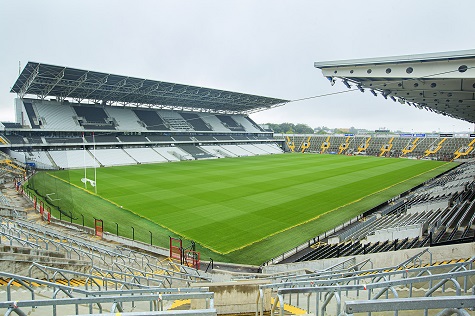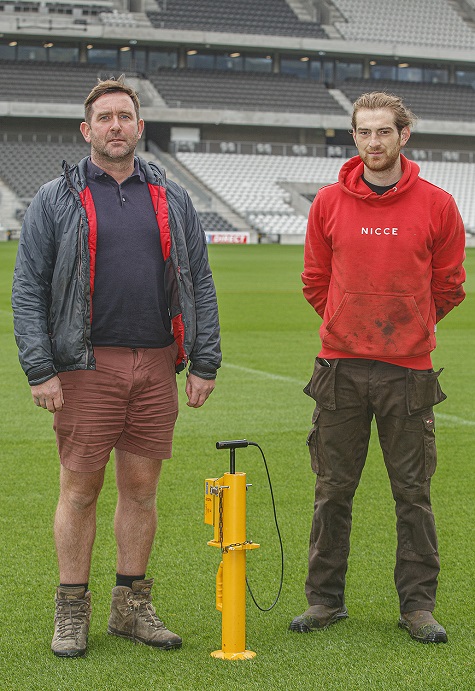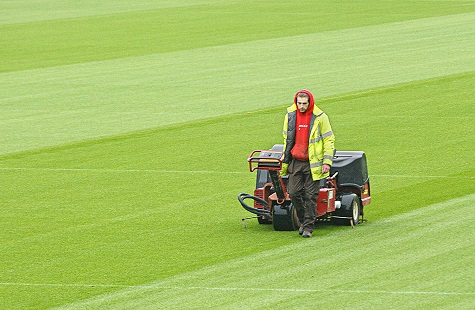The pitch and stadium at Páirc Uí Chaoimh is built near the site of the original Cork Athletic Grounds. It opened in 1976 but closed in 2015 to undergo a huge redevelopment plan before opening its doors again to a state of the art stadium in 2017. It now has a capacity of 45,000 making it the third largest Gaelic stadium in Ireland. The stadium is named after the former GAA General-Secretary Pádraig Ó Caoimh.
In August 2019 an SISGrass Hybrid Stitched pitch was installed. This is only one of two such pitch types in Ireland. As with USGA golf greens they need a specific maintenance programme as 80% of the rootzone is sand based. Stephen Forrest is the man in charge of maintaining the stadium’s pitch. He is also responsible for maintaining the 4G full size floodlit All Weather Astroturf Pitch beside the stadium. This is mainly used for the training of Cork GAA teams, Cork Development squads and Rebel Óg blitzes.

The pitch and stadium at Páirc Uí Chaoimh
Stephen has been looking after the pitch at Páirc Uí Chaoimh since 2010. He began his turf maintenance career as a schoolboy working at Blarney Golf Club during the summer holidays. He got a full time job at Muskerry Golf Club working under the then head greenkeeper Mick Buckley, who only recently retired. “Mick was a big influence on me while I was at Muskerry. He gave me the opportunity to attend a greenkeeping course at the National Botanic Gardens and I soon realized that I wanted to take up greenkeeping as a career”, said Stephen. After spending some time at Muskerry Golf Club Stephen went to Monkstown Golf Club where he got involved with the course nutritional programme. Stephen even spent some time working in Canada at Hurst Creek Golf Club.
Stephen left the greenkeeping world with the intention of starting a turf nursery. “I always dreamt of becoming a head greenkeeper but, at the time, there were few opportunities in Ireland to do this. One thing led to another, and at weekends, I found myself looking after football pitches”, said Stephen.
In 2004 an opportunity arose to set up his own turf maintenance company. With a bank loan he purchased the necessary equipment needed and began trading under the name of TurfTech, which he still runs today.
Talking to Stephen I soon realized how serious he takes his role of maintaining the pitch at Páirc Uí Chaoimh. On the day that I arrived the pitch was in terrific condition thanks to him and his staff.

Head groundsman Stephen Forrest (left) and foreman Jack O’Keeffe
Stephen recently got involved with the National Pitch Development Working Group. Formed in 2017, this is a group of nine people made up of GAA club secretaries and groundsmen from around the country with the aim of highlighting and improving the playing surfaces of GAA pitches. Stephen represents the Munster province in the group. “Most of the pitches in Ireland are maintained by volunteers who have little or no training on how to look after pitches. During the year, in each of the Irish provinces, The National Pitch Development Working Group organises seminars and practical days to guide these volunteers on how to better maintain their pitches”, said Stephen. “Earlier this year, in Munster, we held an ‘ask the pitch expert’ seminar/webinar which was very successful”. Every year a National Pitch of the Year competition is held to encourage clubs to better maintain their pitches. The judges for this competition include Stuart Wilson, Pitch Manager at Croke Park and Dr. Stephen Baker of the STRI.
At the beginning of the lockdown in 2020 there was a lot of uncertainty, especially when it came to who was or was not allowed to work. Even though all sport was cancelled, nobody knew if groundsmen could come in and maintain their turf. Stephen was part of a group of people who lobbied the Irish government to allow GAA pitch maintenance to continue throughout the lockdown. A week later golf clubs were given the green light for their greenkeeping staff to maintain their courses.
Maintenance
Maintaining a GAA pitch is slightly different than maintaining a soccer pitch. Even though the basic principals can be the same when it comes to turf maintenance, there are subtle differences. To begin with, a GAA pitch is almost twice the size of a standard soccer pitch. A GAA pitch can be up to 1.3ha (145m x 90m). Compare this to a premiership pitch of up to 0.74ha (106m x 70m). Another difference is that the playing seasons are different. Most GAA inter county matches are played between May and August while the club county and provincial matches are played between September and December. The English premiership season runs from August to May so there are different windows of opportunity for intensive renovations.
During the growing season the turf is mown each day with the clippings boxed and removed. Keeping the thatch level under control is high on Stephen’s agenda and this is done by scarifying several times throughout the year, along with solid tining. The day I arrived, Jack O’Keeffe, one of the foremen at Páirc Uí Chaoimh, was busy solid tining the pitch.

Jack O’Keeffe solid tining the pitch
The turf on Páirc Uí Chaoimh is 100% perennial ryegrass, which is mown at 32mm in winter and 30mm in summer. Overseeding is done regularly, especially after coring and scarifying, using a blend of the top three cultivars from the STRI Turfgrass Seed List.
Stephen keeps a close eye on any early signs of disease outbreaks and knows when and how to treat it. He also knows when the turf needs feeding and, with the help of soil sample results, will apply the correct amount of nutrition.
The pitch is surrounded by the newly built state of the art stadium. Impressive as it may sound it does lead to challenges for Stephen and his team. The North and South side of the pitch is guarded by roofed seating areas. This leads to shading on the south side of the pitch, in particular, so artificial lighting has to be deployed to keep that section of the pitch healthy. Three x 160m2 lighting rigs are turned on for 12 hours each day.
Because of the high sand content in the rootzone, there are numerous sprinklers installed around the pitch. The water for the irrigation system is collected from the roofs of the terraces and stored in multiple tanks located under the seating areas. 450,000 litres of water is stored in these tanks. This is a great way of putting freely available rainwater to good use without having to resort to other sources for water, which could be scarce and expensive.
Like many large capacity stadiums, Páirc Uí Chaoimh is used to hold concerts. However, because of Covid-19, no concerts were held over the past nineteen months. Now that the restrictions are lifted there are exciting gigs planned for the future. In April 2022 Ed Sheeran takes to the stage and in July it will be the turn of Elton John to visit Páirc Uí Chaoimh, as part of his Farewell Yellow Brick Road The Final Tour concert.
Stephen will take the preparations for these concerts in his stride. “It’s part of maintaining a pitch of this calibre. We’ve done it before so we’ll keep doing it again” he said.